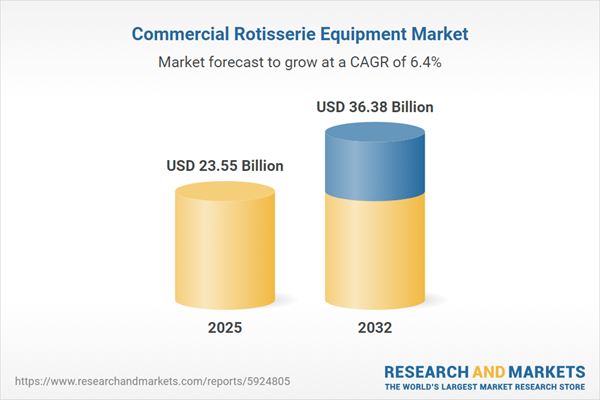Speak directly to the analyst to clarify any post sales queries you may have.
Senior leaders navigating the fast-evolving global foodservice landscape increasingly recognize commercial rotisserie equipment as essential for operational resilience, flavor quality, and customer experience. For executives shaping procurement or portfolio strategies, this report offers a clear, data-driven overview of opportunities, challenges, and shifts influencing this highly dynamic sector.
Market Snapshot: Commercial Rotisserie Equipment Growth and Trends
The global market for commercial rotisserie equipment advanced from USD 22.13 billion in 2024 to USD 23.55 billion in 2025. It is projected to maintain a compound annual growth rate (CAGR) of 6.40%, expected to reach USD 36.38 billion by 2032. This trajectory reflects robust demand across full service restaurants, quick service outlets, retail grocery, and institutional catering, with rising focus on efficiency, product consistency, and regulatory alignment. Heightened investment in automation, digital control interfaces, and modular design is shaping procurement criteria and operational requirements for end users.
Scope & Segmentation
This research analyzes the commercial rotisserie equipment market by core segments, global regions, and applied technologies, providing detailed insight into purchasing drivers and end-user adoption patterns:
- Equipment Types: Conveyor rotisserie, countertop rotisserie, and vertical rotisserie units address diverse throughput and spatial requirements in both high- and low-volume environments.
- End Users: Segmentation covers full service restaurants, quick service restaurants, hotels and resorts, institutional catering operations, and retail/grocery channels, each with unique performance demands and workflow models.
- Power Sources: The market includes charcoal-fired, electric-powered, and gas-powered machines, tailored for flavor preference, energy requirements, and installation flexibility.
- Applications: Rotisserie equipment supports a range of menu uses, such as chicken (whole birds and chicken pieces) and turkey (whole and sliced).
- Capacity Tiers: Options span up to 10 birds, 11 to 20 birds, and above 20 birds, catering to kitchens with variable output needs.
- Regional Markets: Analysis spans the Americas, Europe/Middle East/Africa, and Asia-Pacific, each with sub-regional trends and regulatory influences impacting adoption and channel innovation.
- Key Companies: The market landscape features players including The Middleby Corporation, Ali Group S.p.A, Electrolux AB, Welbilt Inc., RATIONAL AG, Groupe SEB S.A., Alto-Shaam Inc., Henny Penny Corporation, Lincat Group plc, and Nemco Food Equipment Company Inc.
Key Takeaways for Decision-Makers
- Technological advancement is enabling operators to monitor and optimize cook cycles remotely, improving uptime and maintenance efficiency while informing future procurement.
- Growing regulatory pressure and consumer expectations are driving innovation in energy efficiency, emissions reduction, and sustainability features such as heat recovery and renewable energy compatibility.
- Operators are expanding menu applications to include not just whole birds but also marinated pieces and mixed proteins; this shifts the emphasis toward flexible equipment designs with rapid reconfiguration capabilities.
- Purchasing is influenced by integration needs, such as equipment footprint, maintenance accessibility, and seamless fit with existing workflow, as end users seek to reduce downtime and maximize operational agility.
- Market leadership is increasingly determined by investments in service and support—ranging from digital maintenance platforms to robust field technician networks—delivering higher user satisfaction and equipment reliability.
- Strategic alliances and modular design innovations position manufacturers to quickly adapt to changing regional requirements, menu shifts, and evolving cost dynamics.
Tariff Impact on Supply Chains and Cost Structures
The recent imposition of United States tariffs on imported rotisserie equipment has prompted a realignment in supply chain strategies, vendor relationships, and sourcing locations. Manufacturers are diversifying manufacturing footprints and exploring domestic or nearshore partnerships to counter tariff pressures and reduce exposure to trade-related cost fluctuations. Distributors and end-users are increasingly seeking transparency around tariff impacts and leveraging longer procurement contracts to manage risk and ensure consistent supply.
Methodology & Data Sources
This research applies a combination of primary engagements, such as in-depth interviews with manufacturers and operators, and secondary analysis derived from industry publications, regulatory filings, and technical documentation. Rigorous validation—through triangulation of multiple data sources and peer-reviewed quality controls—ensures defensible insights underpin all findings and recommendations.
Why This Report Matters
- Empowers strategic planning by revealing technology trends, regulatory drivers, and end-user preferences across all market segments and regions.
- Offers actionable perspectives to optimize procurement, manage risks—such as tariffs or regulatory shifts—and align offerings with evolving professional kitchen demands.
- Facilitates benchmarking against leading companies, illuminating strategies for service excellence, product innovation, and sustainable growth.
Conclusion
The commercial rotisserie equipment market continues to evolve as operators pursue strategic alignment with technology, consumer needs, and compliance mandates. Stakeholders equipped with clear segmentation and regional insights can position their organizations for sustainable growth and leadership in a competitive marketplace.
Additional Product Information:
- Purchase of this report includes 1 year online access with quarterly updates.
- This report can be updated on request. Please contact our Customer Experience team using the Ask a Question widget on our website.
Table of Contents
3. Executive Summary
4. Market Overview
7. Cumulative Impact of Artificial Intelligence 2025
Companies Mentioned
The companies profiled in this Commercial Rotisserie Equipment market report include:- The Middleby Corporation
- Ali Group S.p.A
- Electrolux AB
- Welbilt, Inc.
- RATIONAL AG
- Groupe SEB S.A.
- Alto-Shaam, Inc.
- Henny Penny Corporation
- Lincat Group plc
- Nemco Food Equipment Company, Inc.
Table Information
| Report Attribute | Details |
|---|---|
| No. of Pages | 186 |
| Published | October 2025 |
| Forecast Period | 2025 - 2032 |
| Estimated Market Value ( USD | $ 23.55 Billion |
| Forecasted Market Value ( USD | $ 36.38 Billion |
| Compound Annual Growth Rate | 6.4% |
| Regions Covered | Global |
| No. of Companies Mentioned | 11 |









